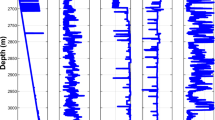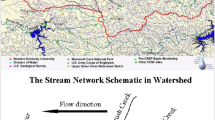Abstract
In this study, numbers type of soft computing including artificial neural network (ANN), support vector machine (SVM), multivariate adaptive regression splines (MARS), and group method of data handling (GMDH) were applied to model and predict energy dissipation of flow over stepped spillways. Results of ANN indicated that this model including hyperbolic tangent sigmoid as transfer function obtained coefficient of determination (R 2 = 0.917) and root-mean-square error (RMSE = 6.927) in testing stage. Results of development of SVM showed that developed model consists of radial basis function as kernel function achieved R 2 = 0.98 and RMSE = 2.61 in validation stage. Developed MARS model with R 2 = 0.99 and RMSE = 0.65 has suitable performance for predicating the energy dissipation. Results of developed GMDH model show with R 2 = 0.95 and RMSE = 5.4 has suitable performance for modeling energy dispersion. Reviewing of results of prepared models showed that all of them have suitable performance to predict the energy dissipation. However, MARS and SVM are more accurate than the others. Attention to structures of GMDH and MARS models declared that Froude number, drop number, and ratio of critical depth to height of step are the most important parameters for modeling energy dissipation. The best radial basis function was found that as best kernel function in developing the SVM.














Similar content being viewed by others
Abbreviations
- ANN:
-
Artificial neural network
- SVM:
-
Support vector machine
- GMDH:
-
Group method of data handling
- MARS:
-
Multivariate adaptive regression splines
- DN:
-
Drop number
- Fr:
-
Froude number
- y c/h :
-
Ratio of critical depth to height of steps
- ANFIS:
-
Adaptive neuro-fuzzy inference system
- GEP:
-
Genetic expression programming
- GA:
-
Genetic algorithm
- PSO:
-
Particle swarm optimization
- GP:
-
Genetic programming
References
Aisenbrey A (1987) Design of small canal structures, 1978. U.S. Government Printing Office, Washington, DC
Azamathulla H, Ghani A (2011) Genetic programming for predicting longitudinal dispersion coefficients in streams. Water Resour Manag 25(6):1537–1544
Azamathulla H, Ghani A, Zakaria N, Guven A (2010) Genetic programming to predict bridge pier scour. J Hydraul Eng 136(3):165–169. doi:10.1061/(ASCE)HY.1943-7900.0000133
Azamathulla HM, Haghiabi AH, Parsaie A (2016) Prediction of side weir discharge coefficient by support vector machine technique. Water Sci Technol Water Supply 16(4):1002–1016
Azamathulla HM, Wu F-C (2011) Support vector machine approach for longitudinal dispersion coefficients in natural streams. Appl Soft Comput 11(2):2902–2905
Azamathulla HM, Yusoff MAM, Hasan ZA (2014) Scour below submerged skewed pipeline. J Hydrol 509:615–620
Boes RM, Chanson H, Matos J, Ohtsu I, Yasuda Y, Takahasi M, Tatewar SP, Ingle RN, Porey PD, Chamani MR, Rajaratnam N (2000) Characteristics of skimming flow over stepped spillways. J Hydraul Eng 126(11):860–873
Chamani MR, Rajaratnam N (1999) Characteristics of skimming flow over stepped spillways. J Hydraul Eng 125(4):361–368
Chanson H (1994) Hydraulics of skimming flows over stepped channels and spillways. J Hydraul Res 32(3):445–460
Chanson H (2002) Hydraulics of stepped chutes and spillways. Taylor and Francis, London
Chen SH (2015) Hydraulic structures. Springer, Berlin
Christodoulou GC (1993) Energy dissipation on stepped spillways. J Hydraul Eng 119(5):644–650
Dehghani M, Saghafian B, Nasiri Saleh F, Farokhnia A, Noori R (2014) Uncertainty analysis of streamflow drought forecast using artificial neural networks and Monte-Carlo simulation. Int J Climatol 34(4):1169–1180
Dong J-R, Zheng C-Y, Kan G-Y, Zhao M, Wen J, Yu J (2015) Applying the ensemble artificial neural network-based hybrid data-driven model to daily total load forecasting. Neural Comput Appl 26(3):603–611
Ebtehaj I, Bonakdari H, Zaji AH, Azimi H, Khoshbin F (2015) GMDH-type neural network approach for modeling the discharge coefficient of rectangular sharp-crested side weirs. Eng Sci Technol Int J 18(4):746–757
Ebtehaj I, Bonakdari H, Zaji AH, Azimi H, Sharifi A (2015) Gene expression programming to predict the discharge coefficient in rectangular side weirs. Appl Soft Comput 35:618–628
Emamgholizadeh S, Bahman K, Bateni SM, Ghorbani H, Marofpoor I, Nielson JR (2016) Estimation of soil dispersivity using soft computing approaches. Neural Comput Appl 1–10. doi:10.1007/s00521-016-2320-x
Emamgolizadeh S, Bateni SM, Shahsavani D, Ashrafi T, Ghorbani H (2015) Estimation of soil cation exchange capacity using genetic expression programming (GEP) and multivariate adaptive regression splines (MARS). J Hydrol 529(Part 3):1590–1600
Felder S, Chanson H (2011) Energy dissipation down a stepped spillway with nonuniform step heights. J Hydraul Eng 137(11):1543–1548
Felder S, Chanson H (2014) Effects of step pool porosity upon flow aeration and energy dissipation on pooled stepped spillways. J Hydraul Eng 140(4):04014002
Friedman JH (1991) Multivariate adaptive regression splines. Ann Stat 19(1):1–67
Frizell KW, Renna FM, Matos J (2013) Cavitation potential of flow on stepped spillways. J Hydraul Eng 139(6):630–636
Gocic M, Shamshirband S, Razak Z, Petković D, Ch S, Trajkovic S (2016) Long-term precipitation analysis and estimation of precipitation concentration index using three support vector machine methods. Adv Meteorol. doi:10.1155/2016/7912357
Ivakhnenko AG (1971) Polynomial theory of complex systems. IEEE Trans Syst Man Cybern 1(4):364–378
Karl A, Lohani A (2010) Development of flood forecasting system using statistical and ANN techniques in the downstream catchment of Mahanadi Basin, India. J Water Resour Protect 2(10):880–887
Khatsuria RM (2004) Hydraulics of spillways and energy dissipators. CRC Press, London
Krishan G, Lohani AK (2015) Application of artificial neural network for groundwater level simulation in Amritsar and Gurdaspur Districts of Punjab, India. J Earth Sci Clim Change 06(05):1–5
Lohani AK, Goel NK, Bhatia KKS (2011) Comparative study of neural network, fuzzy logic and linear transfer function techniques in daily rainfall-runoff modelling under different input domains. Hydrol Process 25(2):175–193
Lohani AK, Goel NK, Bhatia KKS (2014) Improving real time flood forecasting using fuzzy inference system. J Hydrol 509:25–41
Lou I, Xie Z, Ung WK, Mok KM (2016) Freshwater algal bloom prediction by extreme learning machine in Macau Storage Reservoirs. Neural Comput Appl 27(1):19–26
Maghsoodi R, Roozgar MS, Sarkardeh H, Azamathulla HM (2012) 3D-simulation of flow over submerged weirs. Int J Model Simul 32(4):237
Mohammad Rezapour Tabari M, Tavakoli S (2016) Effects of stepped spillway geometry on flow pattern and energy dissipation. Arab J Sci Eng 41:1215–1224. doi:10.1007/s13369-015-1874-8
Montanes JL (2005) Hydraulic canals: design, construction, regulation and maintenance. Taylor and Francis, London
Najafzadeh M (2015) Neuro-fuzzy GMDH based particle swarm optimization for prediction of scour depth at downstream of grade control structures. Eng Sci Technol Int J 18(1):42–51
Najafzadeh M (2015) Neuro-fuzzy GMDH systems based evolutionary algorithms to predict scour pile groups in clear water conditions. Ocean Eng 99:85–94
Najafzadeh M (2016) Neurofuzzy-based GMDH-PSO to predict maximum scour depth at equilibrium at culvert outlets. J Pipeline Syst Eng Pract 7(1):06015001
Najafzadeh M, Azamathulla HM (2015) Neuro-fuzzy GMDH to predict the scour pile groups due to waves. J Comput Civ Eng 29(5):04014068
Najafzadeh M, Barani G-A, Azamathulla HM (2013) GMDH to predict scour depth around a pier in cohesive soils. Appl Ocean Res 40:35–41
Najafzadeh M, Barani G-A, Hessami-Kermani M-R (2014) Group method of data handling to predict scour at downstream of a ski-jump bucket spillway. Earth Sci Inf 7(4):231–248
Najafzadeh M, Barani GA (2011) Comparison of group method of data handling based genetic programming and back propagation systems to predict scour depth around bridge piers. Sci Iran 18(6):1207–1213
Najafzadeh M, Bonakdari H (2016) Application of a neuro-fuzzy GMDH model for predicting the velocity at limit of deposition in storm sewers. J Pipeline Syst Eng Pract 0(0): 06016003
Najafzadeh M, Lim SY (2015) Application of improved neuro-fuzzy GMDH to predict scour depth at sluice gates. Earth Sci Inf 8(1):187–196
Najafzadeh M, Sattar AMA (2015) Neuro-fuzzy GMDH approach to predict longitudinal dispersion in water networks. Water Resour Manag 29(7):2205–2219
Najafzadeh M, Tafarojnoruz A (2016) Evaluation of neuro-fuzzy GMDH-based particle swarm optimization to predict longitudinal dispersion coefficient in rivers. Environ Earth Sci 75(2):1–12
Noori R, Deng Z, Kiaghadi A, Kachoosangi FT (2016) How reliable are ANN, ANFIS, and SVM techniques for predicting longitudinal dispersion coefficient in natural rivers? J Hydraul Eng 142(1):04015039
Noori R, Karbassi A, Ashrafi K, Ardestani M, Mehrdadi N, Nabi Bidhendi G-R (2012) Active and online prediction of BOD5 in river systems using reduced-order support vector machine. Environ Earth Sci 67(1):141–149
Noori R, Karbassi AR, Ashrafi K, Ardestani M, Mehrdadi N (2013) Development and application of reduced-order neural network model based on proper orthogonal decomposition for BOD5 monitoring: Active and online prediction. Environ Prog Sustain Energy 32(1):120–127
Noori R, Karbassi AR, Mehdizadeh H, Vesali-Naseh M, Sabahi MS (2011) A framework development for predicting the longitudinal dispersion coefficient in natural streams using an artificial neural network. Environ Prog Sustain Energy 30(3):439–449
Noori R, Karbassi AR, Moghaddamnia A, Han D, Zokaei-Ashtiani MH, Farokhnia A, Gousheh MG (2011) Assessment of input variables determination on the SVM model performance using PCA, Gamma test, and forward selection techniques for monthly stream flow prediction. J Hydrol 401(3–4):177–189
Noori R, Yeh H-D, Abbasi M, Kachoosangi FT, Moazami S (2015) Uncertainty analysis of support vector machine for online prediction of five-day biochemical oxygen demand. J Hydrol 527:833–843
Ohtsu I, Yasuda Y, Takahashi M (2004) Flow characteristics of skimming flows in stepped channels. J Hydraul Eng 130(9):860–869
Parsaie A, Haghiabi A (2015) The effect of predicting discharge coefficient by neural network on increasing the numerical modeling accuracy of flow over side weir. Water Resour Manag 29(4):973–985
Parsaie A, Haghiabi AH (2015) Predicting the longitudinal dispersion coefficient by radial basis function neural network. Model Earth Syst Environ 1(4):1–8
Pegram GGS, Officer AK, Mottram SR (1999) Hydraulics of skimming flow on modeled stepped spillways. J Hydraul Eng 125(5):500–510
Rajaratnam N (1990) Skimming flow in stepped spillways. J Hydraul Eng 116(4):587–591
Roushangar K, Akhgar S, Salmasi F, Shiri J (2014) Modeling energy dissipation over stepped spillways using machine learning approaches. J Hydrol 508:254–265
Salmasi F, Özger M (2014) Neuro-fuzzy approach for estimating energy dissipation in skimming flow over stepped spillways. Arab J Sci Eng 39(8):6099–6108
Shahheydari H, Nodoshan EJ, Barati R, Moghadam MA (2014) Discharge coefficient and energy dissipation over stepped spillway under skimming flow regime. KSCE J Civ Eng 19(4):1174–1182
Sorensen RM (1985) Stepped spillway hydraulic model investigation. J Hydraul Eng 111(12):1461–1472
Swamee PK, Chahar BR (2015) Design of canals. Springer, India
Author information
Authors and Affiliations
Corresponding author
Rights and permissions
About this article
Cite this article
Parsaie, A., Haghiabi, A.H., Saneie, M. et al. Applications of soft computing techniques for prediction of energy dissipation on stepped spillways. Neural Comput & Applic 29, 1393–1409 (2018). https://doi.org/10.1007/s00521-016-2667-z
Received:
Accepted:
Published:
Issue Date:
DOI: https://doi.org/10.1007/s00521-016-2667-z




